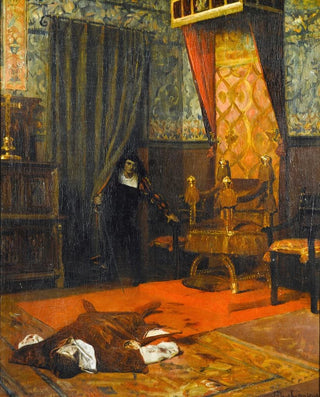Art print | A Victim of the Borgias - Jean-Paul Laurens


View from behind

Frame (optional)
At the heart of the tumult of the Italian Renaissance, the artwork "Une victime des Borgia" by Jean-Paul Laurens stands out as an iconic canvas, revealing the intrigues and passions that marked this era. The scene, filled with drama and tension, depicts the tragic moment when a character, victim of the machinations of the powerful Borgia family, faces their destiny. Laurens, with unparalleled mastery, manages to capture not only the emotional intensity of the scene but also the dark and mysterious atmosphere surrounding these historical figures. This piece transports us to a world where power and betrayal intertwine, inviting reflection on the consequences of excessive ambitions.
Style and uniqueness of the artwork
The canvas is distinguished by its bold use of light and shadow, a chiaroscuro play that heightens the drama of the scene. The faces, finely detailed, express a complex range of emotions, from fear to resignation. The colors, rich and deep, create an almost tangible atmosphere, enveloping the viewer in a mood of anxiety and mystery. Laurens, inspired by the masters of the past, succeeds in blending tradition and innovation, offering a unique vision of his subject. The drapery of the clothing, carefully rendered, adds a sculptural dimension to the composition, reinforcing the impression of movement and urgency. Every element of the artwork, from the choice of colors to the expressions of the characters, testifies to the artist's skill in telling a story through imagery.
The artist and his influence
Jean-Paul Laurens, a major figure of the 19th-century academic movement, established himself through his talent and artistic vision. Trained at the École des Beaux-Arts in Paris, he was influenced by the great masters of art history, while developing a personal style that is uniquely his own. Laurens often explored historical themes, with particular interest in tragic stories and emblematic figures. His work "Une victime des Borgia" fits within this approach, illustrating his ability to handle complex subjects with a

Matte finish

View from behind

Frame (optional)
At the heart of the tumult of the Italian Renaissance, the artwork "Une victime des Borgia" by Jean-Paul Laurens stands out as an iconic canvas, revealing the intrigues and passions that marked this era. The scene, filled with drama and tension, depicts the tragic moment when a character, victim of the machinations of the powerful Borgia family, faces their destiny. Laurens, with unparalleled mastery, manages to capture not only the emotional intensity of the scene but also the dark and mysterious atmosphere surrounding these historical figures. This piece transports us to a world where power and betrayal intertwine, inviting reflection on the consequences of excessive ambitions.
Style and uniqueness of the artwork
The canvas is distinguished by its bold use of light and shadow, a chiaroscuro play that heightens the drama of the scene. The faces, finely detailed, express a complex range of emotions, from fear to resignation. The colors, rich and deep, create an almost tangible atmosphere, enveloping the viewer in a mood of anxiety and mystery. Laurens, inspired by the masters of the past, succeeds in blending tradition and innovation, offering a unique vision of his subject. The drapery of the clothing, carefully rendered, adds a sculptural dimension to the composition, reinforcing the impression of movement and urgency. Every element of the artwork, from the choice of colors to the expressions of the characters, testifies to the artist's skill in telling a story through imagery.
The artist and his influence
Jean-Paul Laurens, a major figure of the 19th-century academic movement, established himself through his talent and artistic vision. Trained at the École des Beaux-Arts in Paris, he was influenced by the great masters of art history, while developing a personal style that is uniquely his own. Laurens often explored historical themes, with particular interest in tragic stories and emblematic figures. His work "Une victime des Borgia" fits within this approach, illustrating his ability to handle complex subjects with a






